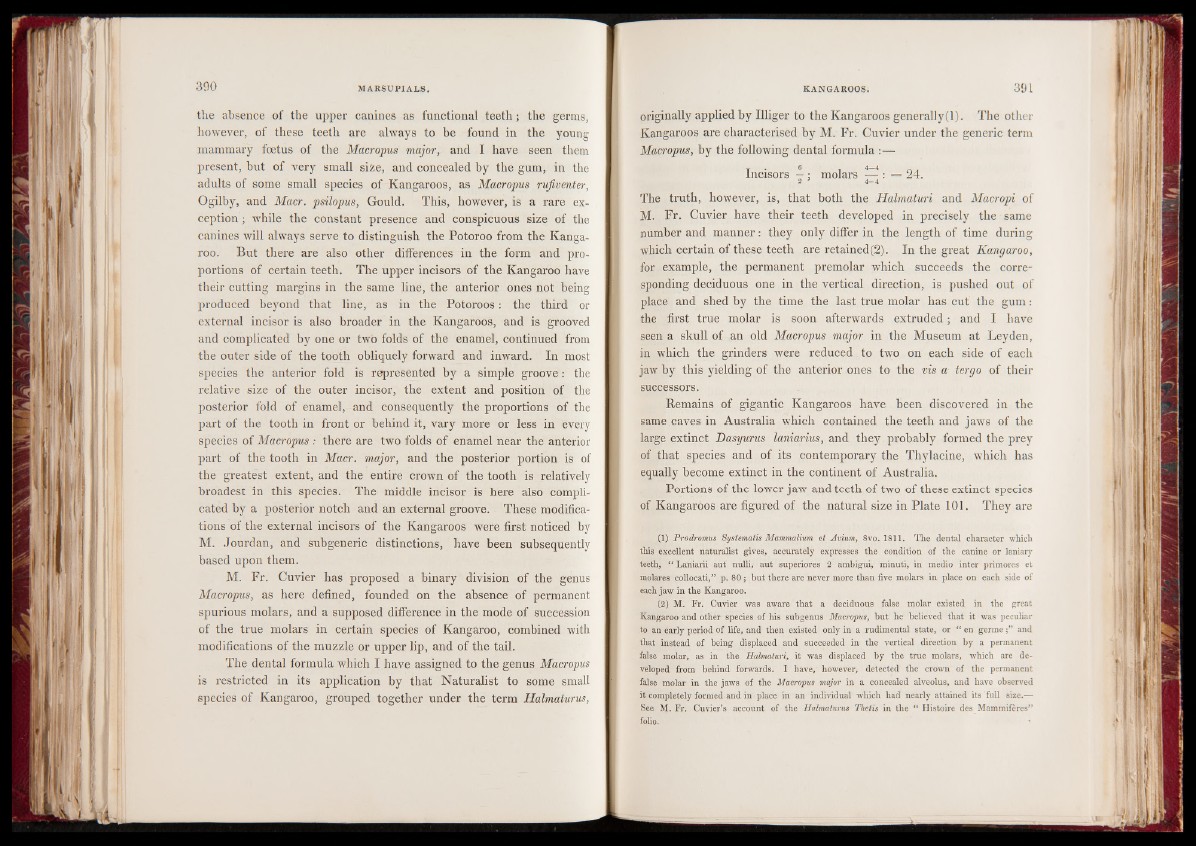
the absence of the upper canines as functional teeth; the germs,
however, of these teeth are always to be found in the young
mammary foetus of the Macropus major, and I have seen them
present, but of very small size, and concealed by the gum, in the
adults of some small species of Kangaroos, as Macropus rujiventer,
Ogilby, and Macr. psilopus, Gould. This, however, is a rare exception
; while the constant presence and conspicuous size of the
canines will always serve to distinguish the Potoroo from the Kangaroo.
But there are also other differences in the form and proportions
of certain teeth. The upper incisors of the Kangaroo have
their cutting margins in the same line, the anterior ones not being
produced beyond that line, as in the Potoroos: the third or
external incisor is also broader in the Kangaroos, and is grooved
and complicated by one or two folds of the enamel, continued from
the outer side of the tooth obliquely forward and inward. In most
species the anterior fold is represented by a simple groove: the
relative size of the outer incisor, the extent and position of the
posterior fold of enamel, and consequently the proportions of the
part of the tooth in front or behind it, vary more or less in every
species of Macropus ' there are two folds of enamel near the anterior
part of the tooth in Macr. major, and the posterior portion is of
the greatest extent, and the entire crown of the tooth is relatively
broadest in this species. The middle incisor is here also complicated
by a posterior notch and an external groove. These modifications
of the external incisors of the Kangaroos were first noticed by
M. Jourdan, and suhgeneric distinctions, have been subsequently
based upon them.
M. Fr. Cuvier has proposed a binary division of the genus
Macropus, as here defined, founded on the absence of permanent
spurious molars, and a supposed difference in the mode of succession
of the true molars in certain species of Kangaroo, combined with
modifications of the muzzle or upper lip, and of the tail.
The dental formula which I have assigned to the genus Macropus
is restricted in its application by that Naturalist to some small
species of Kangaroo, grouped together under the term Halmaturus,
originally applied by Illiger to the Kangaroos generally(l). The other
Kangaroos are characterised by M. Fr. Cuvier under the generic term
Macropus, by the following dental formula :—
Incisors —2 5: molars 4—-4 : = 24.
The truth, however, is, that both the Halmaturi and Macropi of
M. Fr. Cuvier have their teeth developed in precisely the same
number and manner: they only differ in the length of time during
which certain of these teeth are retained(2). In the great Kangaroo,
for example, the permanent premolar which succeeds the corresponding
deciduous one in the vertical direction, is pushed out of
place and shed by the time the last true molar has cut the gum:
the first true molar is soon afterwards extruded; and I have
seen a skull of an old Macropus major in the Museum at Leyden,
in which the grinders were reduced to two on each side of each
jaw by this yielding of the anterior ones to the vis a tergo of their
successors.
Remains of gigantic Kangaroos have been discovered in the
same caves in Australia which contained the teeth and jaws of the
large extinct Dasyurus laniarius, and they probably formed the prey
of that species and of its contemporary the Thylacine, which has
equally become extinct in the continent of Australia.
Portions of the lower jaw and teeth of two of these extinct species
of Kangaroos are figured of the natural size in Plate 101. They are
(1) Prodromus Systematic Mammalium et Avium, 8vo. 1811. The dental character which
this excellent naturalist gives, accurately expresses the condition of the canine or laniary
teeth, “ Laniarii aut nulli, aut superiores 2 ambigui, minuti, in medio inter primores et
molares collocati,” p. 80 ; but there are never more than five molars in place on each side of
each jaw in the Kangaroo.
(2) M. Fr. Cuvier was aware that a deciduous false molar existed in the great
Kangaroo and other species of his subgenus Macropus, but he believed that it was peculiar
to an early period of life, and then existed only in a rudimental state, or “ en germe and
that instead of being displaced and succeeded in the vertical direction by a permanent
false molar, as in the Halmaturi, it was displaced by the true molars, which are developed
from behind forwards. I have,' however, detected the crown of the permanent
false molar in the jaws of the Macropus major in a concealed alveolus, and have observed
it completely formed and in place in an individual which had nearly attained its full size.—
See M. Fr. Cuvier’s account of the Halmaturus Thetis in the “ Histoire des Mammifères”
folio.